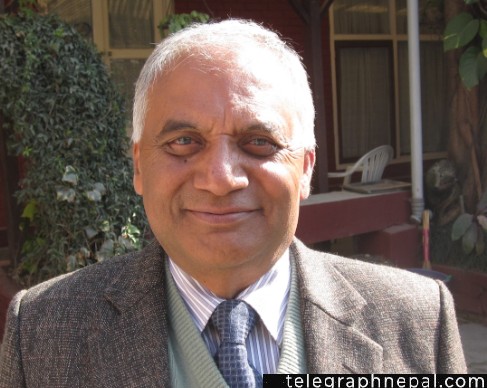Professor Dr. Suman Dhakal, Nepal
-The Turning of a Protectorate Theocracy towards Indian Democracy-
In the lap of the Himalayas, there is a small and beautiful patch of land containing a conglomerate of different races and cultures.
The idyllic land is called Sikkim, once the protectorate state, then an Associate state and finally twenty- second state of the Indian Union.
Prior to her merger with India in 1975, Sikkim was an Indian protectorate-monarchical state ruled by the Namgyal Dynasty, which was established in Sikkim in 1642 AD.
The rulers of the land were known as the Chogyals – a word which in Tibetan means “The Religious King”.
The last ruler of the dynasty was Chogyal Palden Thondup Namgyal, who had to face lot of Political upheavals during the period of his reign. Not only this, his reign was the most crucial period of Sikkimese history, and it proved to be the greatest turning point in the political history of the land.
The Lepchas, Bhutias and the Nepalese are the three major ethnic groups which constitutes the major part of the population of Sikkim. Among these three ethnic groups, the Lepchas are supposed to be the aborigines of the land, whereas the Bhutias and the Nepalese settled later.
Nepalese settlers influenced the socio-economic condition of the land with their superior agricultural methods, especially of paddy cultivation. The Bhutias are the descendants of the Tibetans and the Bhutanese immigrants who had come into the land in the seventeenth century. It is these Bhutias who have along with the Chogyals, always controlled and played a significant role in the political history of the land, especially in the establishment of the Kingdom of Sikkim.
The Chogyal of Sikkim was the direct descendant of these Bhutia people.
Historically speaking, Phuntsog Namgyal was the first ruler of Sikkim, who had been consecrated by the three Monks belonging to the Nying-ma-pa sect of Buddhism, as the Chogyal of Sikkim in the year 1642 and it was he who brought all the communities of Sikkim under one authority and organized the first centralized administration. With the aim of providing better administrative machinery, he divided the state into twelve districts.
Sikkim came into contact with the British India during the reign of Tsugphud Namgyal, the seventh Chogyal of Sikkim, while he turned to the British for help against the fierce attacks of the Nepalese forces under the leadership of King Prithvi Narayan Shah of Nepal.
Owing to the strategic significance of Sikkim, the British also tried to seek her co-operation in their war with Nepal in 1814-15 by a treaty signed at the end of this war. The company government returned the territory occupied by Nepal to Sikkim through the Treaty of Titalia in 1817, in the process however it established the paramount of the British rule over Sikkim and thus paved the way of its predominant role to be played later in the affairs of the state.
In 1935, the ruler of Sikkim, under of Deed of Grant, ceded a strip of her territory, Darjeeling, to the British Government and it readily developed under their tutelage. It also provided the opportunity of emancipation to the people of Sikkim from serfdom, which was then predominant in the Himalayan Kingdoms of Sikkim, Bhutan and Nepal.
The slaves of Sikkim in order to evade persecution were taking refuge in the British territory. The runaway slaves were therefore loss to the upper classes of Sikkim, especially to the Royal family and the landlords of Sikkim.
This issue developed into a permanent cause of hostilities between British India and Sikkim.
However, the issue was temporarily and apparently settled after the signing of the treaty in 1861. As a long term measure it failed to resolve the issue.
In general interest of British trade in the East, the question of establishing trade hostile against the British move to open trade relations with Tibet, not only strictly instructed the Sikkim government not to allow the British mission to transit through her territory, but also warned her of bitter consequences in case of failure.
Beside this, the Tibetans suddenly attacked and occupied two most strategic places-Lingtu Gnatong. Ultimately the British government was forced to send an expeditionary force to settle the Tibeto-Sikkim border dispute which finally came to end with the signing of the convention of March 1890.
Significance of this treaty lies in the fact that on the one hand it fixed the border between Tibet and Sikkim and on the other it also acknowledged the British supremacy in Sikkim. Consequently, Sikkim became a Protectorate state of the British rule.
With the advent of the independence of India the idea of a responsible self-government became a predominant factor too.
In the changed situation a discussion, regarding the internal arrangements and the external affairs of Sikkim and her relationship with India did take place in New Delhi in the presence of the then Maharajkumar (Prince) Palden Thondup Namgyal, representation of the political parties of Sikkim and the representatives of the Government of India.
The result was the signing of an agreement between India and Sikkim on 5th December1950. According to this agreement Sikkim was to continue to be a Protectorate of India. Chogyal Palden Thondup Namgyal – the last Chogyal of Sikkim acceded to the throne in 1963. Just eight months before this he married an American lady Miss Hope Cooke.
Soon after his coronation in 1965, the American Gyalmo (Queen) began to exert her influence on Sikkimese politics. She felt that India had been taking an undue advantage of her powers and viewed the 1950 treaty as imposing and unjust. In an article published in the Institute of Tibetology Bulletin, she claimed that the transfer of the territory of Darjeeling to the British had been quite illegal, and as such claimed that Sikkim still retained her sovereignty over the territory in question.
This was bound to create a controversy.

Furthermore, the anti-Indian campaign in Sikkim thought to be guided by Sikkim Durbar, was continuously catching the wind. Many voices from different corners of the Durbar were r963.aised against the supremacy of India over Sikkim, and the revision of the 1950 treaty between India and Sikkim was staunchly demanded for. This situation set in a kind of cold war between the Sikkim Durbar and the Indian Government, and this unpleasant situation ultimately cost the Chogyal his throne.
On the other hand, the internal picture of Sikkim’s politics itself was far from satisfactory. The whole government machinery was unduly controlled by the feudal traditional aristocrats. There was utmost corruption in every sector. The Chogyal overlooked all these factors and did not try to make any kind of effort towards any new adjustments in the government machinery.
Under the banner of Sikkim Congress, the people of Sikkim strongly protested against the feudal rule and demanded political rights and reforms in their favor.
Although there was a system of election for the Sikkim council it was totally based on racial cleavage and discrimination. The fifth election for the council was held in January 1973, and was highly suspected to have been rigged by the pro-governmental elements.
This made the leaders of the opposition parties as well as the people angry. They protested against this to the Chogyal, but he failed to realize it seriously.
In this way an everlasting confrontation between the Chogyal and the people of Sikkim was triggered and gradually reached the point of no return.
The leaders of the Sikkim Congress sought help from India. Consequently, the Chogyal of Sikkim not only lost his power and position but the tiny Himalayan kingdom lost her independent identity even though it was that of a protectorate Kingdom, and merged with the Indian Union as her twenty second state.
Thus, Palden Thondup Namgyal’s regime proved to be a turning point in the political development of Sikkim as it gradually changed from a Protectorate theocratic Chogyalocracy to Indian democracy.

#The article was also published in Nagaland, India, 2008: Opinions expressed in the article are of the author’s. Editor.

